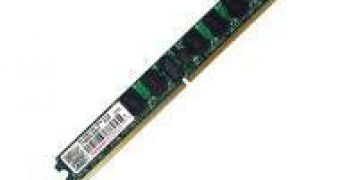Transcend just announced the launch of a new memory module aimed at use in blade and traditional server systems that comes with a nominal capacity of 2GB and it is packed in a very low profile in order to save space in the crammed server cases. Measuring just 18.28mm in height the Transcend 2GB DDR2-667Mhz VLP ECC Registered memory modules are almost 40 percent lower than standard modules, a trait that makes them well suited for use in 1U and thinner blade server systems as well in embedded systems where space is in short supply.
As the new Transcend memory modules are coming packed in such a small form factor, they can be mounted in vertical slots, rather that be housed in the traditional 45 degrees angled memory slots that are the ones mostly used in servers. According to the manufacturing company, the vertical orientation of the memory modules helps them achieve a better heat dissipation as well as an increased airflow, while at the same time allowing for an increased memory density inside the server.
The Transcend 2GB DDR2-667Mhz VLP ECC Registered memory modules are made using a strong eight layered printed circuit board which meets JEDEC's standards for server intended DDR2 memories, while every memory module is made using 18 brand name 256Mx4 DDR2 FBGA (Fine-Pitch Ball Grid Array) chips that are all selected with the utmost care in order to comply with the highest quality standards.
Like all memory modules that are aimed at working in a server environment, the Transcend memories are implementing the ECC technology, but unlike most other solutions, they are based on IBM's advanced ChipKill approach that allows DIMMs to correct multiple errors that spawned from a single memory chip, while standard ECC technology is able to handle only one-bit errors.
As the new Transcend memory modules are aimed at providing a high quality experience they are also backed up by the presence of a lifetime warranty, while being also RoHS compliant and following the latest environmental protective measures of the computer hardware industry.

 14 DAY TRIAL //
14 DAY TRIAL //